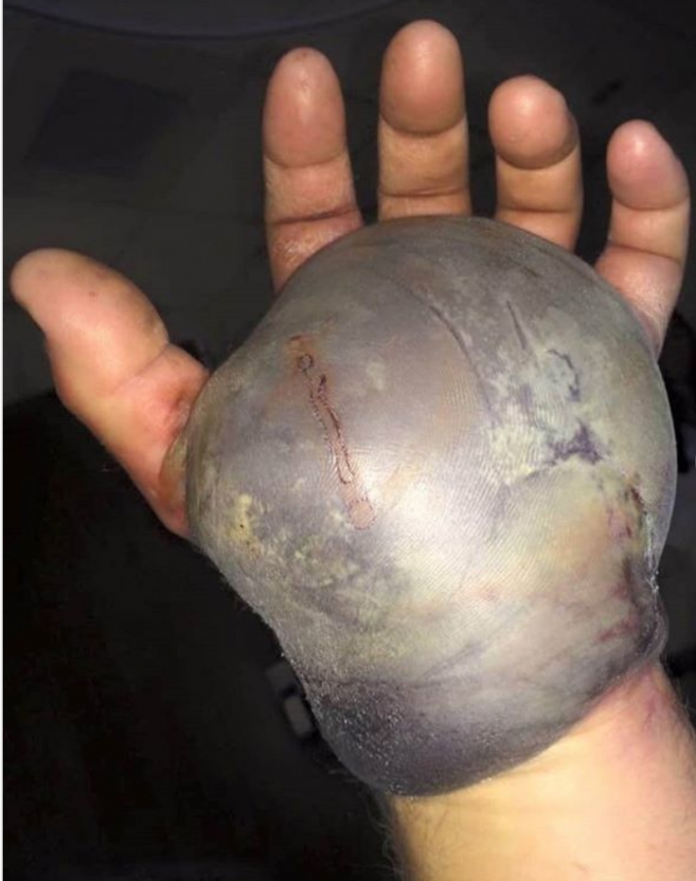No, it’s not a rock in the hand, it is the result of a rattlesnake bite.
Rattlesnakes, also known as pit vipers, have approximately 36 species, all native to South and North America. In North America, a lot of snakebite injuries are attributable to rattlesnake bites. Although it is rarely fatal, it is surely dangerous, therefore prompt treatment is crucial.
The envenomation by the rattlesnake has the highest mortality as compared to other snake bites. The clinical manifestations of a rattlesnake bite are related to its venom. Although rattlesnake rarely bites, when someone provokes it, mishandles or accidentally walks over it, rattlesnake may bite. A rattlesnake digs its hollow fangs into the subcutaneous tissue of its prey, injecting its venom. Although it is rare for the venom to enter the veins but if the venom does enter the venous system, it can get fatal. Locally, the bite may cause pain, bleeding, swelling, redness, oedema, and numbness. When the venom spreads beyond the bite site, it can cause systemic signs such as blurring of vision, nausea, vomiting, lacrimation, perspiration, dizziness, tissue necrosis, difficulty breathing, etc. these symptoms can be exaggerated in children with the same amount of venom as children have more venom per unit of body surface area. Therefore, snake bites are more dangerous in children.
The venom of rattlesnake contains two neurotoxins, one is canebrake toxin and the other is an enzyme phospholipase A2. These two neurotoxins, in higher concentrations, can cause paralysis of muscles by blocking calcium channels thereby inhibiting neuromuscular transmission at the neuromuscular junction.
Some species have hemotoxins too. The hemotoxins affect the circulatory system, deranging the clotting profile, increasing the bleeding tendency, hence causing internal bleeds.
The rattlesnake species that contain more neurotoxin than hemotoxin are more hazardous.
First Aid measure after snakebite:
Usually, snakebites happen to be when the individual is quite away from a medical facility, making it a challenge. Therefore, people who are more exposed to such environments should be particularly aware of the first aid measures.
- The bite wound should be washed with clean soap water with the bitten area kept immobile and lower than the heart level to maintain circulation.
- Remove any jewellery that is near the bitten area.
- Try to get medical help immediately, if not possible to get medical attention within 30 minutes, tie a bandage up to 4 inches above the wound to slow the venom spread. NEVER tie it tight enough to hamper the arterial supply and venous return. If you are unsure, try to slip a finger beneath the bandage.
Above all, carry a snake bite kit on such journeys and remember the DON’Ts of first-aid: - No ice, no tourniquets, no wound incisions and no electric shocks for a snakebite victim.
When the patient is brought to the medical facility, an IV line is maintained to give boluses of normal saline. Local and systemic symptoms are observed. Blood should be drawn to check for coagulation markers. Except for life-threatening situations, platelets or fresh frozen plasma (FFP) transfusions should be avoided. In severe cases, after initial resuscitation, anti-venom is the best bet.
References:
Venomous snakes. Centers for Disease Control and Prevention. https://www.cdc.gov/niosh/topics/snakes/. Accessed June 24, 2019
Snakebites. Merck Manual Professional Version. https://www.merckmanuals.com/professional/injuries-poisoning/bites-and-stings/snakebites?query=snake%20bite. Accessed June 24, 2019.
Patel V, Hamilton RJ. Rattle Snake Toxicity. [Updated 2019 May 6]. In: StatPearls [Internet]. Treasure Island (FL): StatPearls Publishing; 2020 Jan-. Available from: https://www.ncbi.nlm.nih.gov/books/NBK431065/




